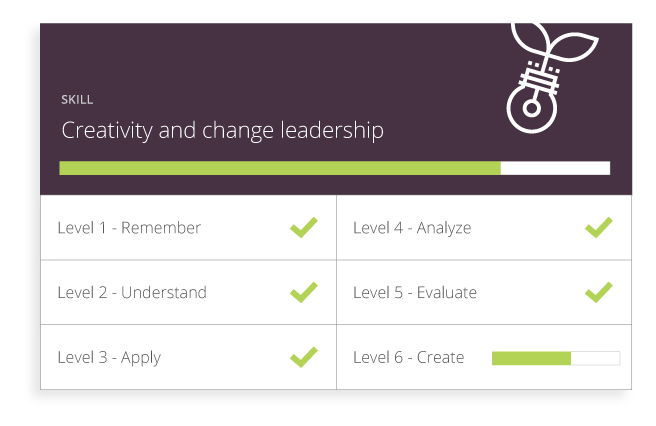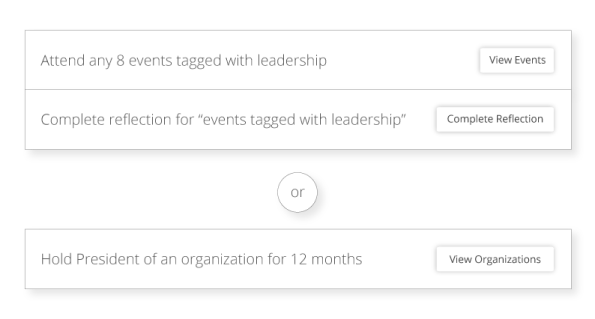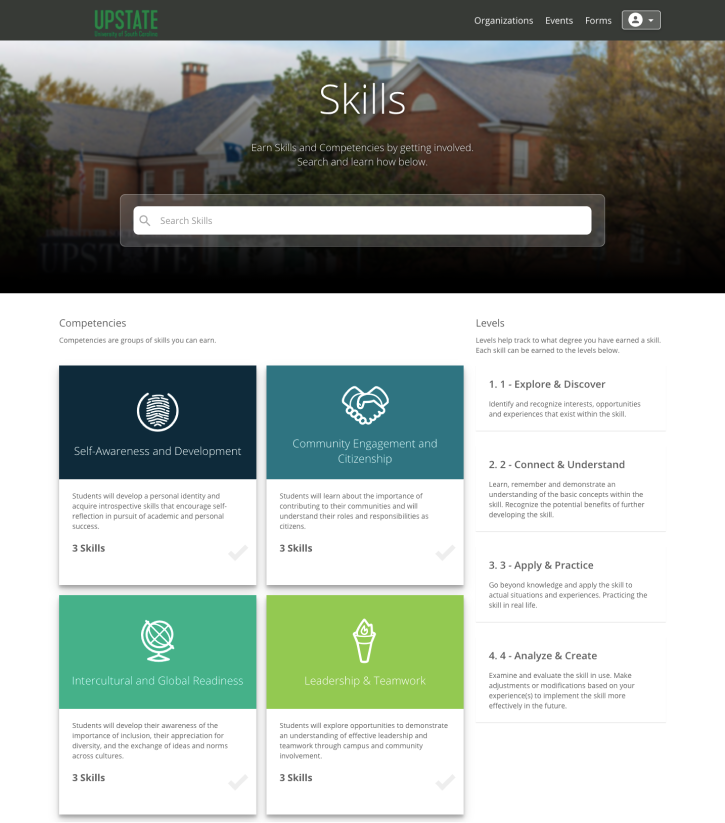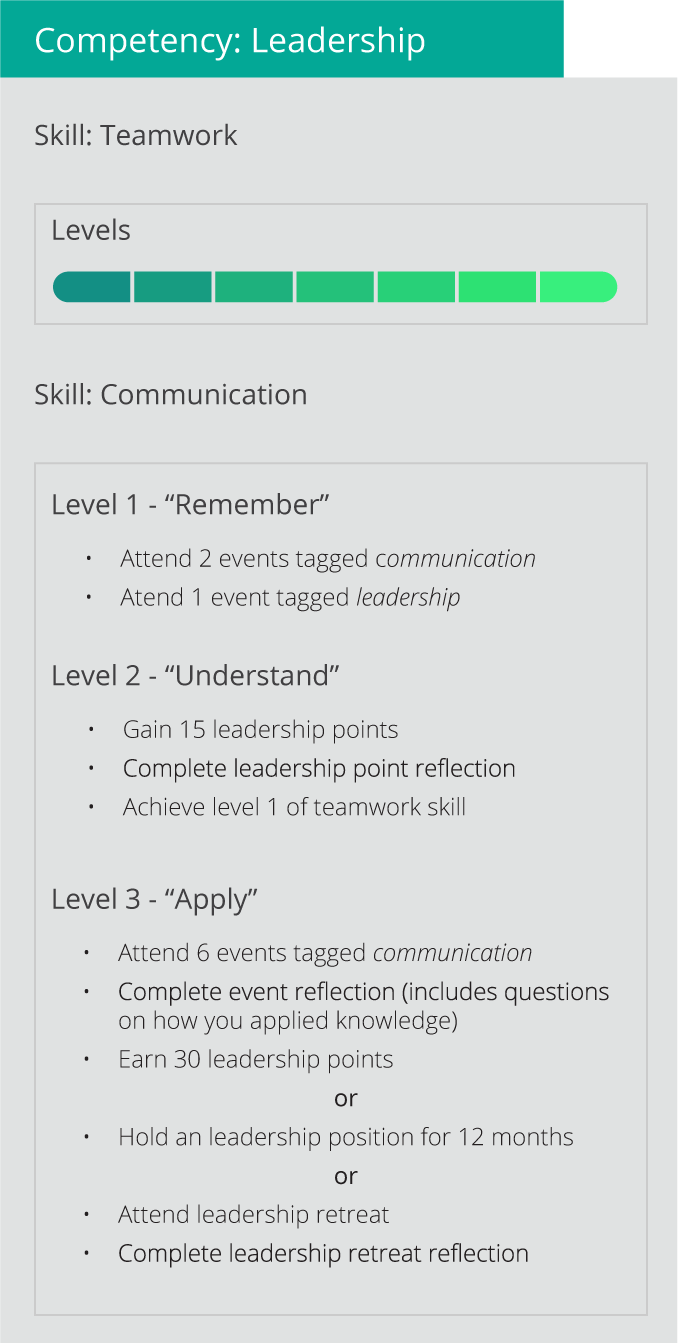We know that our students learn and develop skills through the co-curricular opportunities we offer on our campuses.
But, when our students are first getting involved on campus, motivation for involvement is typically spurred by a desire to make new friends and develop a deeper connection to the campus community.
While those reasons for engagement are important, I believe we can help students be more intentional in how, precisely, they decide to invest their time outside of class. Early on, we can help them select and engage with co-curricular activities that complement their academic, personal, and professional journeys. Cue co-curricular learning pathways.
What are co-curricular pathways?
Last year, Inside Higher Ed published a piece about co-curricular pathways, in which author Terry Vaughan III wrote that “pathways intentionally align programs and services toward specific goals and learning outcomes.”
Vaughan outlined three elements of co-curricular pathways:
- high-impact experiences
- scaffolded learning
- ideals of student success that help students to shape and reach their academic and professional goals.”
This article resonated with me as I was in the midst of developing co-curricular pathways at my own institution. It reaffirmed the idea that developing pathways is necessary to better serve our students and to help them maximize the short time they have with us on campus.
In a recent survey by New America, students indicated their number one reason for enrolling in college is to improve their employment opportunities. Students are eager for their institutions to help them learn workforce-ready skills in exciting new ways.
If designed well, co-curricular pathways can do exactly that. Co-curricular pathways should not create new barriers for your students. Rather, these pathways should make engagement seem even easier and more meaningful, setting students up with the essential, marketable skills they need post-graduation!
If you’re ready to put on your theoretical hardhat and start constructing pathways, here are some tips for getting started.
Planning
Complete your background research
Although they may not be called “co-curricular learning pathways” everywhere and by everyone, institutions are starting to align their programs and opportunities in ways that guide students toward more intentional engagement.
One example that really excited me when I first began building pathways for my own students was Creighton University’s comprehensive student record. Their pathways are well-defined, easy for students to navigate, and capture the holistic student experiences of their campus.
You may also find the co-curricular pathways created by the University of South Carolina Upstate, Harford Community College, or the University of Washington Tacoma to be inspiring!


Examples of skills and pathways built out through Presence
Conducting some research and finding examples like these allowed me to provide some context when I approached my team with my idea for our campus. Seeing that other similar institutions were investing in this type of initiative helped jumpstart our work.
Get stakeholders on board from the beginning
As I began to consider different pathway structures that might entice our students, it quickly became apparent that co-curricular pathway development should be a campus-wide undertaking.
The long-term success of your co-curricular learning pathways will require buy-in from all campus stakeholders. Make it easy on yourself by involving faculty, staff, students (and maybe even alumni or business partners) from the get-go. Before you publicly announce that you are working on this initiative, be sure to have a plan for how you will engage stakeholders throughout the process.
Stakeholders should be involved in the development phase, the feedback phase, and the implementation phase.
Plan for program stability
Good programming ideas can quickly fall to the wayside if you don’t consider their stability early on.
When any new program is introduced, the workload is always an immediate concern for folks around the table. But, If you can develop a plan for program leadership and management early on, you will ease the fears that this new initiative will be dumped on someone’s plate without appropriate compensation or, worse, that it will fall apart right after its development.
Ask yourself: how could this type of program be managed? Is there an existing position on campus that could serve as the point of contact? Could tracking and assessment of the pathways be managed via software? Are there partners on campus who can assist in our marketing?
Development
In this part of the process, consider making these your primary agenda items:
Develop pathways theme and outcomes
What is the theme of your pathways initiative as a whole? In other words, what commonalities will define each pathway? Do they align with institutional or divisional learning goals? Do they align with specific skills or learning outcomes? Do they complement career or academic field categories?
How you decide this will ultimately come down to what is most important to your institution. If, for example, your campus has a strong mission of “preparing a workforce,” you might opt for pathways that align with specific career categories, like Carleton College did.
Once you have determined the theme of your pathways, you’ll then need to determine the specific outcome(s) you hope students achieve by engaging with said pathways.
For example, the University of Auckland’s “Global Citizens Path” includes the following outcomes for students:
- Possess a global outlook and multicultural perspective, displayed through a commitment to the betterment of society.
- Be an open thinker who appreciates the riches of diversity and equity.
- Be positioned to create a sustainable future that considers social, cultural, environmental and economic consequences of global issues.
The outcomes associated with each of your pathways will help you determine the type of tasks you would like students to complete.

USC Upstate’s co-curricular framework, leading to pathways, as displayed in its branded Presence portal
Create a simple structure
To ensure easy navigation for students, keep the pathways simple. You can do so by developing a framework for requirements that are consistent across all pathways. This could mean narrowing the number of total pathways and the number of criteria/tasks required of each pathway.
First, let’s talk about the number of pathways. Four or five is likely an ideal number — enough to give your students options without confusing or overwhelming them. Then, within each pathway, I recommend having a mix of criteria and required tasks, along with some electives that allow students to “choose their own adventure” while still meeting the goals of the pathway.
One of the pathways at my institution is “Engage Globally” and students must select 3 elective criteria to complete within it. Among other choices, they can complete foreign language coursework beyond graduation requirements or write an essay on their experience as an international student or a first or second-generation immigrant.

Example of pathways for a hypothetical institution’s teamwork skill
Delegate work using pathways subcommittees
After you’ve determined your pathway themes and outcomes, it’ll be time to pull in stakeholders to serve on subcommittees. These folks will help you finish developing the details of each pathway.
Having subcommittees is not only a way to keep the development work more manageable; it’s also an opportunity to foster campus-wide buy-in and excitement while creating opportunities for subject-matter experts to work on pathways where they can make an impact. I call that a win for all involved!
Complete an institutional co-curricular inventory
Now comes the fun work of reviewing your institution’s co-curricular portfolio. Your goal here should be to identify opportunities that align with a particular pathway’s outcomes.
If you assemble your subcommittees well, this inventory work can be fairly easy — as members will share their expertise about the co-curricular programs they work with. But beyond the expertise of the subcommittee, be sure to think holistically about all of the co-curricular options on your campus and how they might fit into a pathway.
Think beyond just student organizations; consider all the high-impact practices your institution has to offer. Additionally, consider opportunities that aren’t official programs. Student employment positions are a great example. Being a career ambassador or a teaching assistant will undoubtedly help a student develop transferable workforce skills and achieve certain pathway outcomes.
Another great example: if you have a pathway focusing on diversity, which my institution has named “Embracing Difference,” perhaps students could opt to complete an LGBTQIA+ safe space training.
Feedback
With any new initiative, seeking feedback from campus stakeholders is a necessary step for seeing your work finally come to fruition. I recommend a comprehensive feedback phase that allows you to gather information in a variety of ways to ensure that you reach key populations on campus.
Seek feedback from your colleagues
It is worth your time on the front end to present your work to campus faculty, staff, and other leadership. If they have any hesitations, then you will have already lost key advocates who could have encouraged students to engage with these pathways.
Taking the time to do a few presentations with stakeholders will allow you to answer their questions, ease any fears about how you will implement and manage pathways, and incorporate any final feedback. In short, it’ll assure every stakeholder that their voice was part of this process.
Engage your student leaders
The feedback you gather from students is perhaps the most valuable of all. But be sure to seek out a wide variety of student populations.
Get on the agenda at your student senate’s meetings to introduce your pathways, host a forum in your commuter student lounge or as a floor event in Res Halls, or lead a Q&A session for FYE seminars. Physically go to where your leaders are and create the space for them to ask questions and contribute ideas.
Complete a random sampling exercise
Another great way to get solicit student feedback is through random sampling.
If you were to implement your newly designed pathways today, would most students be on track to complete at least one of the pathways? Would they be interested in enrolling in one? The best way to test this is through random sampling. Get a mix of first-years, older students, and non-traditional students such as commuters and part-time enrollees.
For first-years, your primary goal is to see if they would opt into enrolling because they see the value in the pathways goals and criteria.
For students who have been on campus longer, you will want to survey how many already completed some of the requirements that are part of a pathway. If students who are close to graduating have completed some of the requirements, that’s a good indicator that the pathways are already a natural fit for your campus and could reasonably be completed by each student’s last day of classes.
Implementation
You’ve made it to the implementation phase. Congratulations! You’ve done your due diligence in crafting pathways that are meaningful while gathering feedback and engaging stakeholders along the way. There is a good chance that you have some pretty serious buzz around this initiative now, so now is time to finally implement it.
Messaging and informational access are key to implementation. To do this, you need to:
Develop a clear, compelling message as to why students should pursue co-curricular pathways.
You should get students to see engaging in your co-curricular pathways as a rewarding development opportunity, not just another requirement to add to their to-do lists. Your marketing materials should detail the benefits students receive from not only navigating a pathway but completing one as well. Lynn University does a great job at describing the value of their different pathways, as well as skills students are developing as a result of each “level” they complete within that pathway.
Ease access to information online
Like I mentioned earlier, you should design pathways with the goal of enhancing co-curricular engagement, not deterring from it. So, be sure to make it easy for a student to find their pathway(s) by creating a centralized location on your campus website or student engagement portal that students can easily access and navigate.
Students should be able to quickly find the available co-curricular pathways, learn about each of them, enroll in them, and find contact information for a staff member to connect with if they have questions. (Hundreds of institutions — including UNC Asheville, The University of West Georgia, and Manhattanville College have done exactly that through Presence.)
Share student stories
You probably understand the power of students sharing their stories with their peers. So, as students begin to enroll in your pathways, consider sending out a short survey asking students what inspired them to pursue a co-curricular pathway. Plus, ask them to share a photo that you could post to social media or a website with their story.
As more students begin to navigate their pathways, continue seeking student stories about their experiences and ask them to provide advice for future students pursuing that pathway.
Creating co-curricular pathways can seem like a large undertaking, but it’s worthwhile and doable for any institution! With intentional processes for planning, development, feedback, and implementation, you can lead a campus-wide initiative that will deepen the co-curricular experience for your students in a way that sets them up for long-term success and gives them the workforce-ready skills students expect out of higher education.
Want to learn more? Check out these additional resources:
- The Top 6 Benefits of Establishing a Learning Outcome Framework (blog post)
- How to Adapt or Build Your Co-Curricular Learning Outcome Framework (blog post)
- Designing Learning Pathways: Gamifying and Automating Co-Curricular Skill Development (webinar)
- The Complete Guide to High-Impact Practices (free ebook)
- The Complete Guide to Co-Curricular Learning (free ebook)





